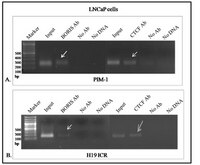Expression of the cancer-testis antigen BORIS correlates with prostate cancer.
Cheema, Z; Hari-Gupta, Y; Kita, GX; Farrar, D; Seddon, I; Corr, J; Klenova, E
The Prostate
74
164-76
2014
概要を表示する
BORIS, a paralogue of the transcription factor CTCF, is a member of the cancer-testis antigen (CT) family. BORIS is normally present at high levels in the testis; however it is aberrantly expressed in various tumors and cancer cell lines. The main objectives of this study were to investigate BORIS expression together with sub-cellular localization in both prostate cell lines and tumor tissues, and assess correlations between BORIS and clinical/pathological characteristics.We examined BORIS mRNA expression, protein levels and cellular localization in a panel of human prostate tissues, cancer and benign, together with a panel prostate cell lines. We also compared BORIS levels and localization with clinical/pathological characteristics in prostate tumors.BORIS was detected in all inspected prostate cancer cell lines and tumors, but was absent in benign prostatic hyperplasia. Increased levels of BORIS protein positively correlated with Gleason score, T-stage and androgen receptor (AR) protein levels in prostate tumors. The relationship between BORIS and AR was further highlighted in prostate cell lines by the ability of ectopically expressed BORIS to activate the endogenous AR mRNA and protein. BORIS localization in the nucleus plus cytoplasm was also associated with higher BORIS levels and Gleason score.Detection of BORIS in prostate tumors suggests potential applications of BORIS as a biomarker for prostate cancer diagnosis, as an immunotherapy target and, potentially, a prognostic marker of more aggressive prostate cancer. The ability of BORIS to activate the AR gene indicates BORIS involvement in the growth and development of prostate tumors. | 24123052
 |










